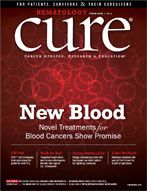Publication
Article
CURE
Keeping Blood Cancers in Focus
Author(s):
September was Blood Cancer Awareness Month, a time to offer support to patients and spread awareness about these diseases both inside and outside the cancer community.
September was Blood Cancer Awareness Month, a time to offer support to patients and spread awareness about these diseases both inside and outside the cancer community.
While that event is behind us, December’s annual meeting of the American Society of Hematology is just ahead, promising a wealth of the most cuttingedge news in the field. With that in mind, we at CURE wanted to take this time to focus on blood cancers — and the terrific progress being made in treating them. The advances in targeted treatments and immunotherapies, and the progress being made in combining these agents with each other and with older medications, deserve a lot of attention: These improvements are heralding a new age in blood cancer treatment.
In this issue, we look in detail at the evolution of treatments for the spectrum of blood cancers, and at novel strategies being researched in clinics around the world that could lead to new breakthroughs.
Recent advances in chronic myeloid leukemia have been so dramatic that they were recognized with the Cancer Advance of the Year award, given in January by the American Society of Clinical Oncology. Our article on CLL mentions the two targeted therapies and two immunotherapies approved by the U.S. Food and Drug Administration in just the last two years, as well as a host of newer treatments in development.
The much-talked-about immunotherapy technique of chimeric antigen receptor (CAR) T cell therapy takes center stage in our article about acute myeloid leukemia, and the merits of cocktails of newer and older drugs are detailed in our articles about the treatment of multiple myeloma and B-cell lymphomas.
To be sure, side effects, sometimes severe, are still real issues for patients with blood cancers, and most treatments are not yet curative. But progress is being made and, for many, outcomes are improving. For instance, our article on myeloma explains that experts are close to considering the disease a chronic condition, some of them seeing the potential for a cure on the horizon.
Looking at the larger experience of the cancer patient is an important part of our mission at CURE, and in that vein we’ve included several articles in this issue that look beyond treatment. One focuses on the importance of, and rewards associated with, donating or receiving stem cells for transplant, and another on the high costs of blood-cancer therapies. We round out the issue with tips for caregivers on helping their loved ones avoid infection while immunocompromised after stem cell transplant.
We hope this special issue of CURE achieves its goal: to offer information you won’t find anywhere else while providing inspiration and support to help you through your cancer journey.
As always, thank you for reading.
Mike Hennessy, SrChairman and CEO






